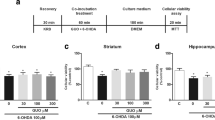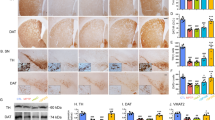Abstract
The neurotoxin 1-methy-4-phenylpyridinium (MPP+) is used for its’ capacity to induce Parkinsonism through its inhibitory effects on mitochondrial complex I. This inhibition disrupts cellular energy formation and aerobic glycolysis. The objective of this study was to demonstrate that the toxic effect of mitochondrial aerobic pathway inhibition with MPP+ can be reduced by stimulating anaerobic glycolysis using glucose supplementation. In this study, C6 Glioma cell viability was examined in the presence of different concentrations of MPP alone and with the addition of glucose. The results obtained indicate that there was a significant increase (P < 0.001) in cell viability in cells treated with glucose and MPP+ verses cells treated with MPP+ alone. Fluorometric analysis using 100 uM Rhodamine 123 indicated mitochondrial membrane potential was not restored in MPP+ treated cells with glucose; however, normal cell viability was confirmed using 2 ug/ml Fluorescein diacetate. This dual fluorescence indicated mitochondrial damage from MPP+ while glucose augmented cell survival. Further confirmation of cell survival upon damage to the mitochondria was evident in TUNEL staining. Positive staining was prominent only in MPP+ treatment groups alone, while control and co-treated groups exhibited little to no TUNEL staining. ATP measurements of all MPP+ treated groups exhibited a significant (P < 0.001) decrease verses control. Groups co-treated with MPP+ and glucose revealed a significant increase (250 μM group: P < 0.001) in ATP. It was concluded from this study that glucose supplementation was able to sustain cellular viability and ATP production through anaerobic glycolysis despite the inhibitory effect of MPP+ on aerobic glycolysis.








Similar content being viewed by others
References
Blum D, Torch S, Lambeng N, Nissou M-F, Benabid A-L, Sadoul R, Verna J-M (2001) Molecular pathways involved in the neurotoxicity of 6-OHDA, dopamine, and MPTP: contribution to the apoptotic theory in Parkinson’s disease. Prog Neurobiol 65:135–172
Nicklas WJ, Vyas I, Heikkila RE (1985) Inhibition of NADH-linked oxidation in brain mitochondria by 1-methyl-4-phenylpyridine, a metabolite of the neurotoxin 1-methyl-4-phenyl-1, 2, 3, 6-tetrahydropyridine. Life Sci 36:2503–2508
Ramsay RE, Singer RP (1986) Energy-dependent uptake of N-methyl-4-phenylpyridinium, the neurotoxic metabolite of 1-methyl-4-phenyl-1, 2, 3, 6-tetrahydropyridine by mitochondria. J Biol Chem 75:85–7587
Di Monte D, Sandy MS, Ekstrom G, Smith MT (1986) Comparative studies on the mechanisms of paraquat and 1-methyl-4-phenylpyridinium (MPP+) cytotoxicity. Biochem Biophys Res Commun 137:303–309
Denton T, Howard BD (1987) A dopaminergic cell line resistant to the neurotoxin. 1-methyl-4-phenyl-1, 2, 3, 6-tetrahydropyridine. J Neurochem 49:622–630
Chan P, DeLanney LS, Irwin I, Langston JW, Di Monte D (1984) Rapid ATP loss caused by of 1-methyl-4-phenyl-1,2,3,6-tetrahydropyridine in mouse brain. J Neurochem 57:348–351
Scotcher KP, Irwin I, DeLanney LE, Langston JW, Di Monte D (1990) Effects of 1-methyl-4-phenyl-1, 2, 3, 6- tetrahydropyridine and 1-methyl-4-phenylpyridinium ion on ATP levels of mouse synaptosomes. J Neurochem 54:1295–1301
Dauer W, Przedborski S (2003) Parkinson’s disease: mechanisms and models. Neuron 39:889–909
Smith MT, Ekstrom G, Sandy MS, Di Monte D (1987) Studies on the mechanism of cytotoxicity in isolated hepatocytes. Life Sci 40:741–748
Mizuno Y, Saitoh T, Sone N (1987) Inhibition of mitochondrial NADH–ubiquinone oxidoreductase activity by 1-methylphenylpyridinium ion. Biochem Biophys Res Commun 143:294–299
Chan P, DeLanney LS, Irwin I, Langston JW, Di Monte D (1991) Rapid ATP loss caused by of 1-methyl-4-phenyl-1,2,3,6-tetrahydropyridine in mouse brain. J Neurochem 57:348–351
Di Monte DA, Wu EY, Irwin I, Delanney LE, Langston JW (1991) Biotransformation of in primary cultures of mouse astrocytes. J Pharmacol Exp Ther 258:594–600
Bates TE, Heales SJ, Davies SE, Boakye P, Clark JB (1994) Effects of 1-methyl-4-phenylpyridinium on isolated rat brain mitochondria: evidence for a primary involvement of energy depletion. J Neurochem 63:640–648
Forno LS, Delanny LE, Irwin I, Di Monte D, Langston JW (1992) Astrocytes and Parkinson’s disease. Prog Brain Res 94:429–436
Chiba K, Trevor A, Castagnoli N Jr (1984) Metabolism of the neurotoxic tertiary amine, MPTP, by brain oxidase. Biochem Biophy Res Comm 120:574–578
Langston JW, Irwin I, Langston EB, Forno LS (1984) 1-Methyl-4-phenylpyridinium ion (MPP+): identification of a metabolite of MPTP, a toxin selective to the substantia nigra. Neurosci Lett 48:87–92
Ransom BR, Kunis DM, Irwin I, Langston JW (1987) Astrocytes convert the parkinsonism inducing neurotoxin, MPTP, to its active metabolite, MPP+. Neurosci Lett 75:323–328
Brooks WJ, Jarvis MF, Wagner GC (1989) Astrocytes as primary locus for the conversion of MPTP in MPP+. J Neural Transm 76:1–12
Wu EY, Langston JW, Di Monte DA (1992) Toxicity of the 1-methyl-2, 3-dihydtopyridinium and 1-methyl-4-phenylpryidinium species in primary cultures of mouse astrocyte. J Pharmacol Exp Ther 62:2259–2230
Mazzio E, Soliman K (2003) The role of glycolysis and gluconeogenesis in the cytoprotection of neuroblastoma cells against 1-methyl-3-phenyl-pyridinium ion toxicity. Neurotoxicology 24:137–147
Di Monte DA, Wu EY, Delanney Irwin I, Langston JW (1992) Toxicity of 1-methyl-4-phenyl-1,2,3,6-tetrahydropyridine in primary cultures of mouse astrocytes. J Pharmacol Exp Ther 261:144–149
Marcelo MN, Assaf S, Petros B, Carlo R (1998) A novel one-step, highly sensitive fluorometric assay to evaluate cell-mediated cytotoxicity. J Immunological Methods 213:157–167
Youngster SK, Sonsalla PK, Heikkila RE (1987) Evaluation of the biological activity of several analogs of the dopaminergic neurotoxin 1-methyl-4-phenyl-1, 2, 3, 6-tetrahydropyridine. J Neurochem 48:989–934
Basma AN, Heikkila RE, Nicklas WJ, Giovanni A, Geller HM (1990) 1-Methyl-4-phenyl-1,2,3,6-tetrahydropyridine and 1-methyl-4- (2`-ethylphenyl)-1,2,3,6- tetrahydropyridine induced toxicity in PC12 cells: role of monoamine oxidase A. J Neurochem 55:870–877
Chamlmers-Redman RM, MacLean Fraser AD, Carlile GW, Pong A, Tatton WG (1999) Glucose protection from MPP-induced apoptosis depends on mitochondrial membrane potential and ATP synthase. Biochem Biophy Res Comm 257:440–447
Hertz L, Yager JY, Juurlink BHJ (1995) Astrocyte survival in the absence of exogenous substrate: comparison of immature and mature cells. Int J Dev Neurosci 13:523–527
Hassouna I, Wickert H, Zimmermann M, Gillardon F (1996) Increase in bax expression in substantia nigra following 1-methyl-4-phenyl-1, 2, 3, 6-tetrahydropyridine (MPTP) treatment of mice. Neurosci Lett 204:85–88
Tatton NA, Kish SJ (1997) In situ detection of apoptotic nuclei in the substantia nigra compacta of 1-methyl-4-phenyl-1, 2, 3, 6-tetrahydropyridine-treated mice using terminal deoxynucleotidyl transferase labeling and Acridine Orange staining. Neuroscience 77:1037–1048
Eberhardt O, von Coelln R, Kügler S, Lindenau J, Rathke-Hartlieb S, Gerhardt E, Haid S, Isenmann S, Gravel C, Srinivasan A, Weller M, Bähr M, Dichgans J, Schulz JB (2000) Protection by synergistic effects of adenovirus-mediated X-chromosome-linked inhibitor of apoptosis and glial cell line-derived neurotrophic factor gene transfer in the 1-methyl-4-phenyl-1,2,3,6-tetrahydropyridine model of Parkinson’s disease. J Neurosci 20:9126–9134
Turmel H, Hartmann A, Parain K, Douhou A, Srinivasan A, Agid Y, Hirsch EC Caspase-3 activation in 1-methyl-4-phenyl-1,2,3,6-tetrahydropyridine (MPTP)-treated mice. Mov Disorders 16:185–189
Viswanath V, Wu Y, Boonplueang R, Chen S, Stevenson FF, Yantiri F, Yang L, Beal MF, Andersen JK (2001) Caspase-9 activation results in downstream caspase activation and bid cleavage in 1-methyl-4-phenyl-1,2,3,6-tetrahydropyridine-induced Parkinson’s disease. J Neurosci 21:9519–9528
Itano Y, Nomura Y (1995) 1-Methyl-4-phenylpyridinium ion (MPP+) causes DNA fragmentation and increases the Bcl-2 expression in human neuroblastoma, SH-SY5Y cells through different mechanisms. Brain Res 704:240–245
Sheehan JP, Palmer PE, Helm GA, Tuttle JB (1997) MPP+ induced apoptotic cell death in SH-SY5Y neuroblastoma cells: an electron microscope study. J Neurosci Res 48:226–237
Dipasquale B, Marini AM, Youle RJ (1991) Apoptosis and DNA degradation induced by 1-methyl-4-phenylpyridinium in neurons. Biochem Biophys Res Comm 181:1442–1448
Du Y, Dodel RC, Bales KR, Jemmersom R, Hamilton- Byrd E, Paul SM (1997) Involvement of a caspase-3-like cysteine protease in 1-methyl-4-phenylpyridinium-mediated apoptosis of cultured cerebellar granule neurons. J Neurochem 69:1382–1388
Mochizuki H, Nakamura N, Nishi K, Mizuno Y (1994) Apoptosis is induced by 1-methyl-4-phenylpyridinium ion (MPP+) in ventral mesencephalic-striatal co-culture in rat. Neurosci Lett 170:191–194
Acknowledgments
This work was supported by a grant received from the National Institutes of Health (RR 03020).
Author information
Authors and Affiliations
Corresponding author
Rights and permissions
About this article
Cite this article
Williams, Z.R., Goodman, C.B. & Soliman, K.F.A. Anaerobic Glycolysis Protection against 1-Methy-4-Phenylpyridinium (MPP+) Toxicity in C6 Glioma Cells. Neurochem Res 32, 1071–1080 (2007). https://doi.org/10.1007/s11064-006-9276-7
Received:
Accepted:
Published:
Issue Date:
DOI: https://doi.org/10.1007/s11064-006-9276-7




